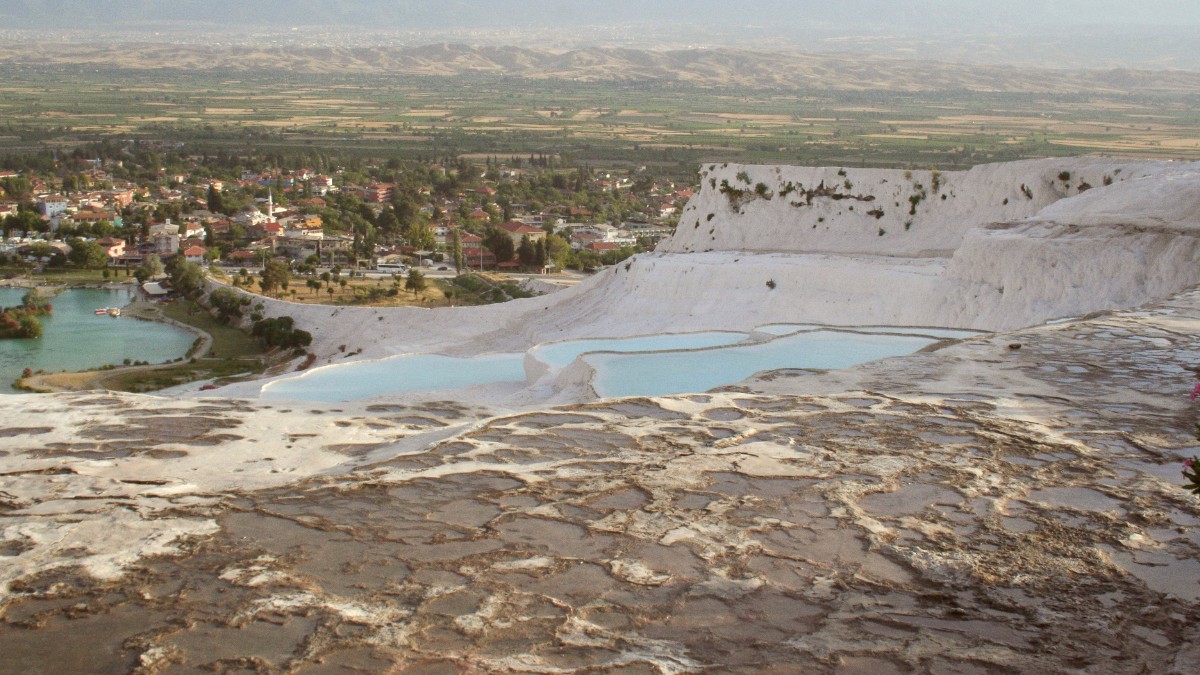
Aegean Coast, Turkey
Pamukkale's landscape presents opportunities for both gentle exploration and exhilarating adventure.
Walking through the extensive ancient city of Hierapolis can be considered a moderate hike. The site is large, covering uneven terrain with ancient paths and steps. Exploring the full extent of the ruins needs good walking ability. Plan for several hours of walking.
The barefoot walk on the designated paths of the travertines is an unique experience. It is generally easy in terms of physical exertion but needs care due to slippery surfaces. The incline is gentle, making it accessible for most visitors.
Swimming in this warm, mineral-rich thermal pool is the main water activity. The unique aspect is swimming among submerged ancient Roman columns, presenting a blend of relaxation and historical immersion. The water maintains a pleasant temperature year-round.
No official campsites are directly adjacent to the Pamukkale travertines or Hierapolis site. Some private campgrounds exist further afield in the broader Denizli region. Research specific options if camping is planned.
Engage with Turkish culinary traditions and local customs.
Pamukkale does not have widely developed formalized community-based tourism initiatives. However, choosing to stay in locally owned guesthouses and dining at family-run restaurants directly supports the Pamukkale community and presents opportunities for genuine interaction with locals.
No formal language schools operate in Pamukkale. Locals appreciate the effort when you learn a few basic Turkish phrases like "Merhaba" (Hello) and "Teşekkür ederim" (Thank you).
Local festivals mainly occur in Denizli city, typically related to agriculture, local traditions, or public holidays. These are usually aimed at locals but present an authentic cultural experience if your visit coincides with one. Check the Denizli municipality's cultural calendar.
Regular public cultural performances or traditional ceremonies are not a common feature in Pamukkale village. Some hotels might arrange occasional folk dance performances for groups.
Visiting olive groves, vineyards, or local farms in the wider Denizli region is possible. These are not typically direct tourist offerings but offer a glimpse into agricultural life.
Pamukkale is a natural spa destination, presenting various ways to relax and rejuvenate through its thermal waters.
The natural pools on the white terraces contain warm, mineral-rich water. Soaking your feet in these pools is a simple, natural therapy often enjoyed by visitors. The water is believed to have beneficial effects on skin and circulation.
This is the main thermal swimming experience in Pamukkale. The pool's water is naturally warm, and swimming among the submerged ancient Roman columns presents an unique, relaxing, and historically rich experience.
Located a short distance from Pamukkale, Karahayıt is known for its iron-rich red waters. These springs create "red travertines" and fill the pools of the local thermal hotels. The red waters are believed to be beneficial for various ailments, specifically skin and rheumatic conditions.
Pamukkale is not a main destination for structured yoga or meditation retreats. However, some wellness-focused thermal hotels might present basic yoga classes or quiet spaces suitable for meditation for their guests.
Thermal bathing itself constitutes a traditional healing practice in this region, dating back to ancient times. The local belief in the healing powers of the mineral waters has persisted for centuries. Many locals visit the thermal springs for their perceived health benefits.
Pamukkale is inland, so it does not have beach clubs. Hotels in Pamukkale village and Karahayıt often have their own swimming pools, some of which are thermal pools, presenting places to relax and swim.
Pamukkale presents a quiet evening ambiance. Nightlife options are limited, focusing more on relaxed dining than bustling entertainment.
No nightclubs or dedicated dancing venues are available in Pamukkale village. Nightlife options are very limited. Denizli city presents some clubs, but they mainly cater to a local audience and are not a major tourist draw.
Pamukkale does not feature specific bar districts or organized pub crawls. Alcohol is available in tourist-oriented restaurants and hotels, but the scene is generally quiet and focused on dining.
Generally, evenings in Pamukkale are quiet. Visitors typically enjoy dinner at a local restaurant, perhaps with a view of the illuminated travertines, and then retire. The focus is on relaxation after a day of sightseeing.
Pamukkale offers a peaceful ambiance after sunset, ideal for a relaxed dinner or quiet contemplation of the illuminated travertines.
The limited nightlife promotes early starts, allowing visitors to experience the attractions without the midday crowds and heat.
For a more active nightlife, Denizli city presents options tailored to a local audience, including cafes and some clubs, but it is not a major tourist nightlife destination.
Pamukkale is a destination for natural beauty and history. Its nightlife is low-, allowing for quiet evenings and early starts to avoid crowds at the attractions.